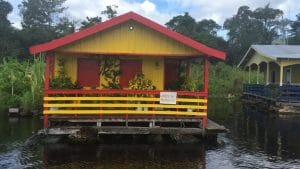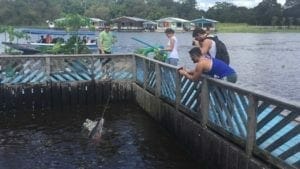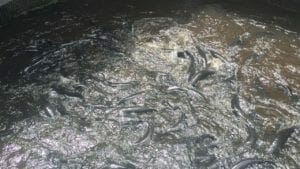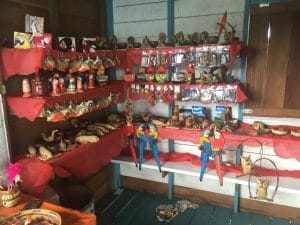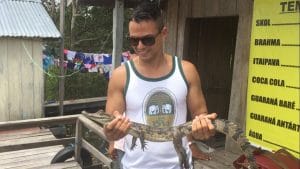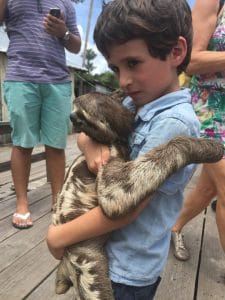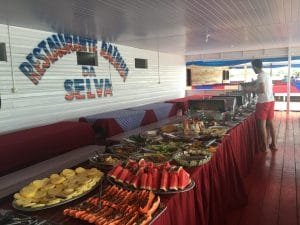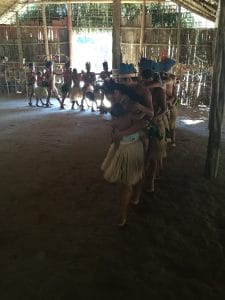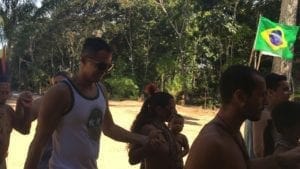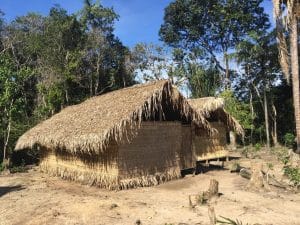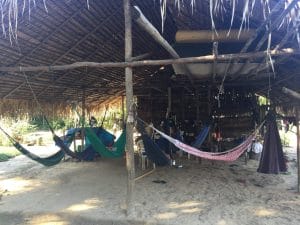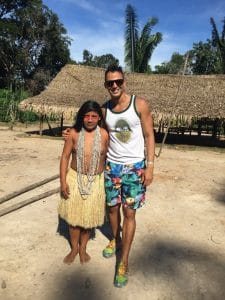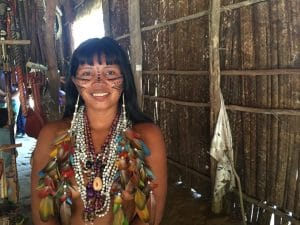Table of Contents
Do you want take a tour in Manaus?
When I started planning a trip to the Amazon, I was pretty convinced that I would take the best tour in Manaus, which would include swimming with the pink dolphins and visiting an indigenous tribe.
Among a myriad of travel agencies I chose Amazing Tours because I knew from a friend’s recommendation that they would deliver a high quality tour with reasonable prices.
I arrived in Manaus in the afternoon and the next day the driver picked me up at the hostel. The day was perfect for a tour: blue sky, sunny and not that hot.
I joined some more people on the port and we took a boat that was very good with comfortable seats (we were going to travel 150km and spend around 6h on this tour), a restroom and free cold potable water.
The guide was very knowledgeable and spoke English, Portuguese and Spanish perfectly.
On the way to the first stop he told us interesting facts about Manaus and also the importance of the rivers for the people of the Amazon.
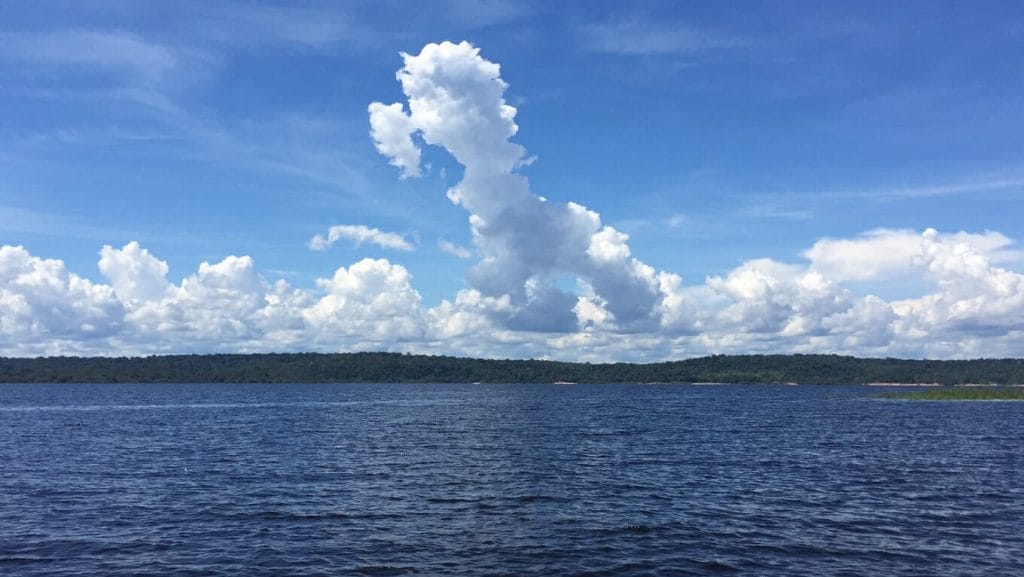
The Encounter of the waters
The first stop of this tour in Manaus was one of the most interesting phenomena that I have ever seen: the meeting of waters.
Rio Negro (Black River) that starts in Colombia and Rio Solimões that starts in Peru meet to form the Amazon River, one of the largest rivers in the world.
But the most interesting and intriguing fact is that those two rivers flow together, side-by-side, between 6 and 18 Km without mixing!
Those rivers have different temperatures, densities and flow speeds. The muddy rich nutrients and sandy coloured waters of the Rio Solimões, is faster colder and denser than the dark acid water of the Rio Negro, so that the two rivers look different as they wend their way to the Amazon.
I was in awe and started to understand why people venerate these rivers and how important they are for the population. Such a magical moment!!
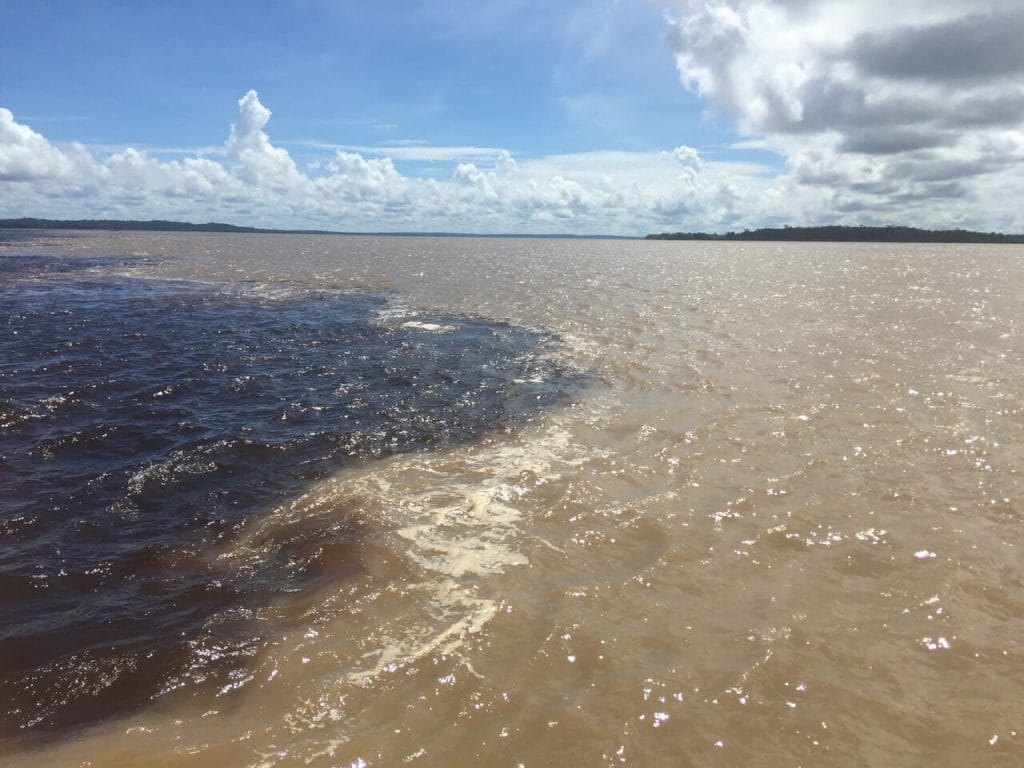
Floating village
The boat headed to the second stop of this tour in Manaus, a floating village close by and we had the opportunity to learn about the lifestyle of its inhabitants.
There were colourful houses, school, market and even a small soccer field.
We stopped at one dock with stores selling local arts and crafts, a bar with tables, umbrellas and a place for fishing.
Well, we didn’t fish properly and basically fed huge pirarucus (a typical fish from the Amazon that can get 2m long) because we didn’t have a hook.
The pirarucus ate all the bait so fast, but even though, it was fun.
Interaction with wildlife
The boat left the floating village and headed to a Janauary Ecological Reserve, the first Ecological Park in Manaus. But before getting there we stopped on a floating bar so we could interact with some animals.
A caiman, a sloth and a big anaconda were just there waiting for us.
I was never a big fan of snakes and especially anaconda that can eat you easily, but once I was there, I could not miss the opportunity to put one around my neck. I felt fine and scared at the same time because it was licking my skin the whole time…
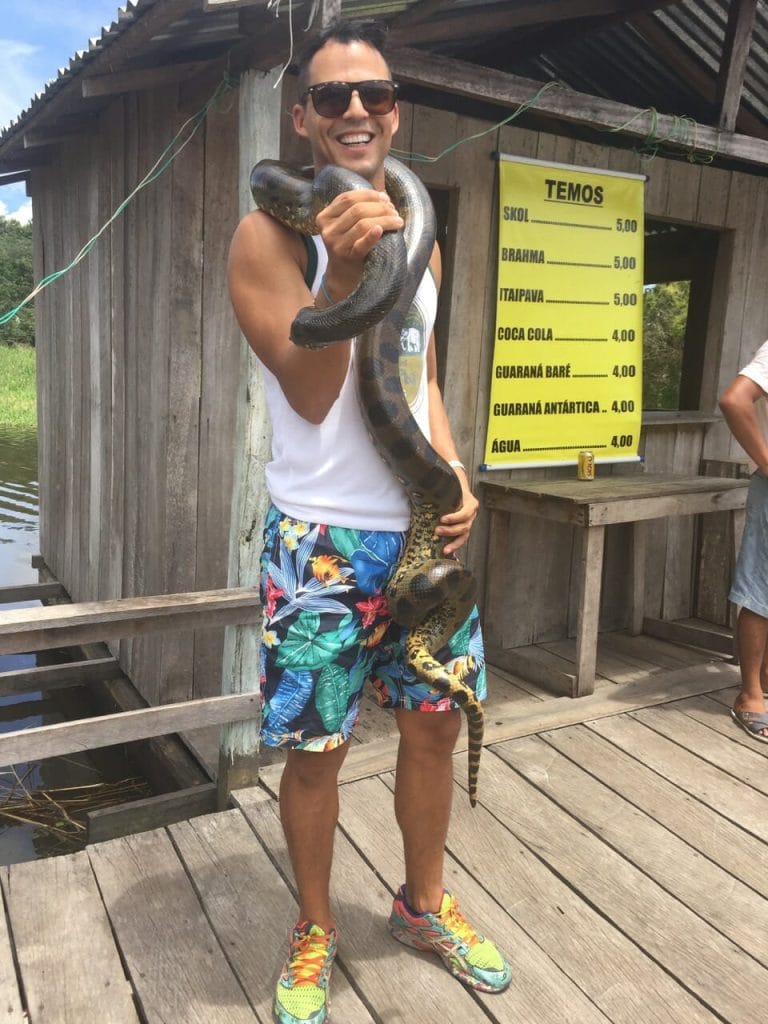
The baby caiman (1.5 years old and around 50cm long) was pretty quiet, maybe stressed from its long hours “working”; the sloth was just so adorable that you wanted to pet it for hours and hours.
We arrived at Janauary Park to have lunch, see some arts and crafts made by the indigenous natives in floating communities and monkeys.
This park is so beautiful and has a long suspension bridge in the middle of the trees.
When I started walking on the bridge I saw already some small and really cute monkeys coming toward me. These little guys were so energetic and fast, however, I manage to get close to them.
In the end, there were some big and lovely lily pads that are so common on the Amazon, another caiman and a 4m long anaconda.
The lunch served in this tour in Manaus was amazing with a great variety of fishes, salad and fresh juices, with outstanding quality. After lunch, the boat went back to the port to drop off some people and headed to one of the most expected moments and one of the reasons I came to Manaus.
Swimming with the pink dolphin
When we left Manaus port the sun was even stronger. The bright blue sky contrasted with the lush vegetation surrounding the river, and sometimes I wanted to jump off the boat and enjoy some swimming along the way.
At this point I had made some friends who were also taking this tour in Manaus, and we were talking, laughing and specially admiring the stunning landscape.
We sailed on the Rio Negro for around 40min until the floating platform where we would swim with the pink dolphin.
The pink dolphin is full of legends, and although I’m a Brazilian, I never really took it seriously. The legend for the ancestral people of the Amazon was that the porpoise would transform into a handsome man and seduce the maidens and women of the riverside communities. There are tales of homosexual and female porpoises. It is interesting that these myths served as an excuse for unacceptable behaviour, such as unwanted pregnancy, or an effeminate boy… Therefore many of these animals were killed in the past, and also they were considered a problem for fishermen.
Nowadays the pink dolphins are not killed and have become one of the main attractions on the Amazon, charming thousand of visitors from everywhere in the world.
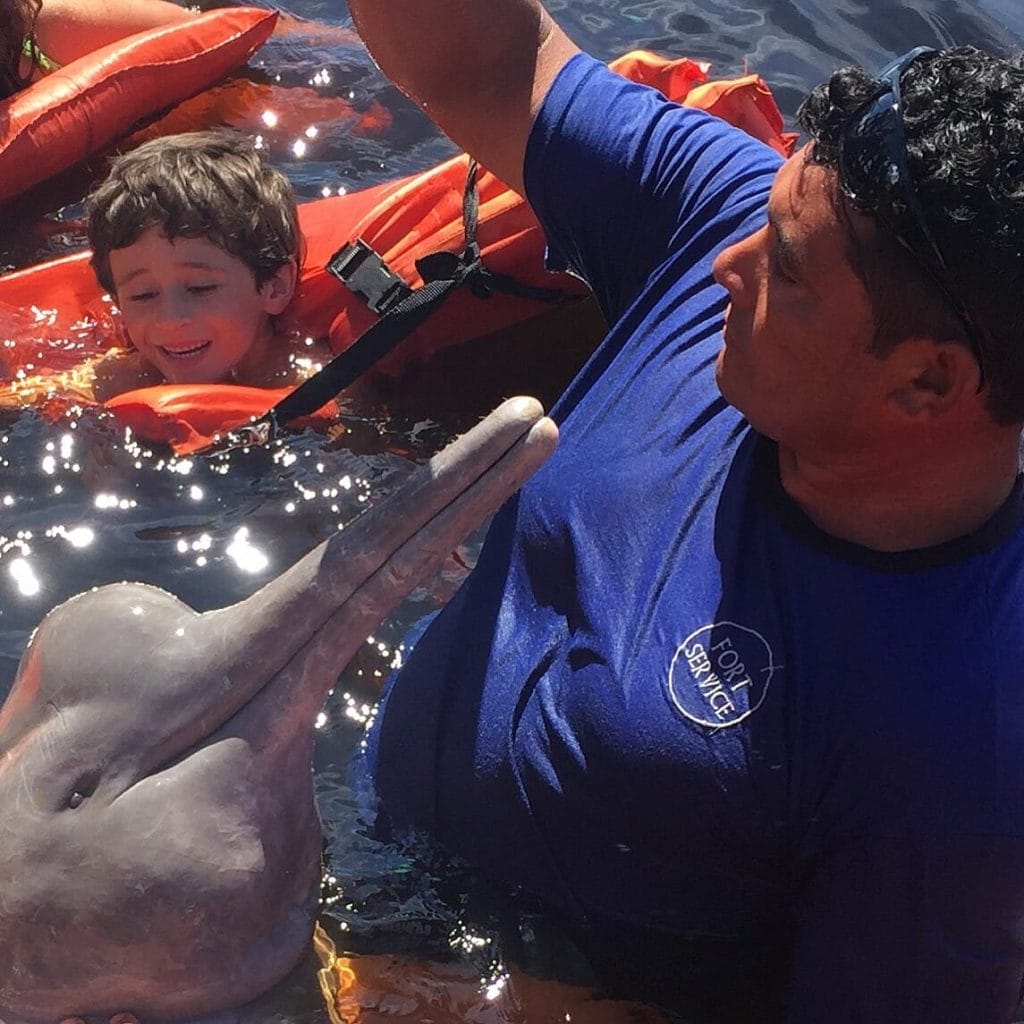
We jumped off the boat, put our life vests on and finally went in the water.
As soon as I stepped into the river I saw some pink dolphins swimming just a few feet from me. The water was a kind of pocket and everyone was eager to see, touch and swim with these animals.
The dolphins were not bothered by us and they continued swimming underneath our legs and hitting some of us. We were so surprised and laughed.
I was touching and swimming with pink Dolphins for the first time in my life!
The master who feeds them jumped in the water and another guy started throwing some fishes to him. The pink Dolphins were coming to be fed and we gathered around to see it. Everyone had a chance to pet them because they seemed so hypnotized by the master and the fishes they were eating. What a sweet animal!!
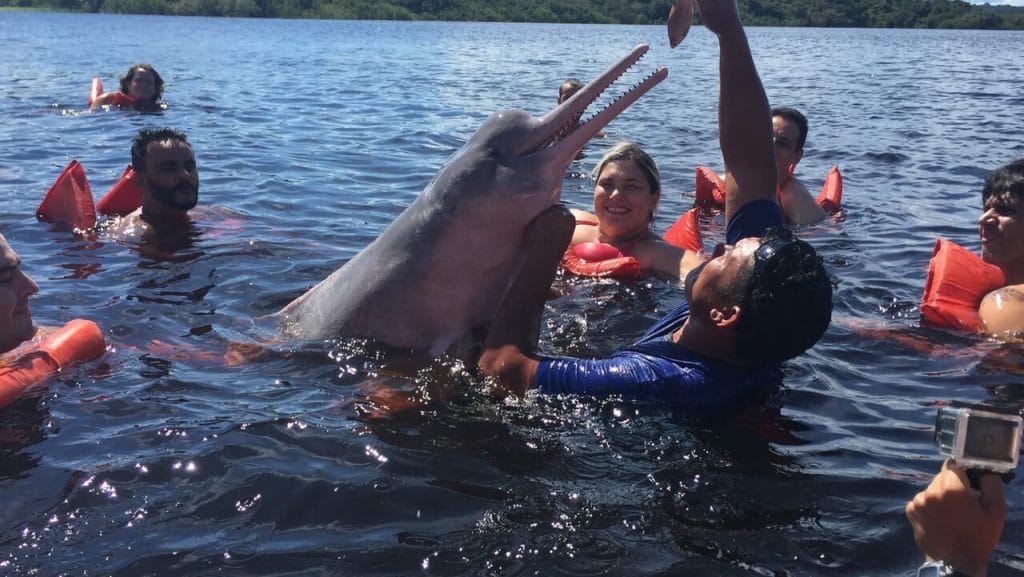
When the fishes were over the dolphins left. And although our guide was calling us we didn’t want to leave. After the whole day under the sun, we just wanted to stay in the water.
But we had to leave because after swimming with the pink dolphin we would visit an indigenous tribe and I was really looking forward to it.
Visiting an indigenous tribe
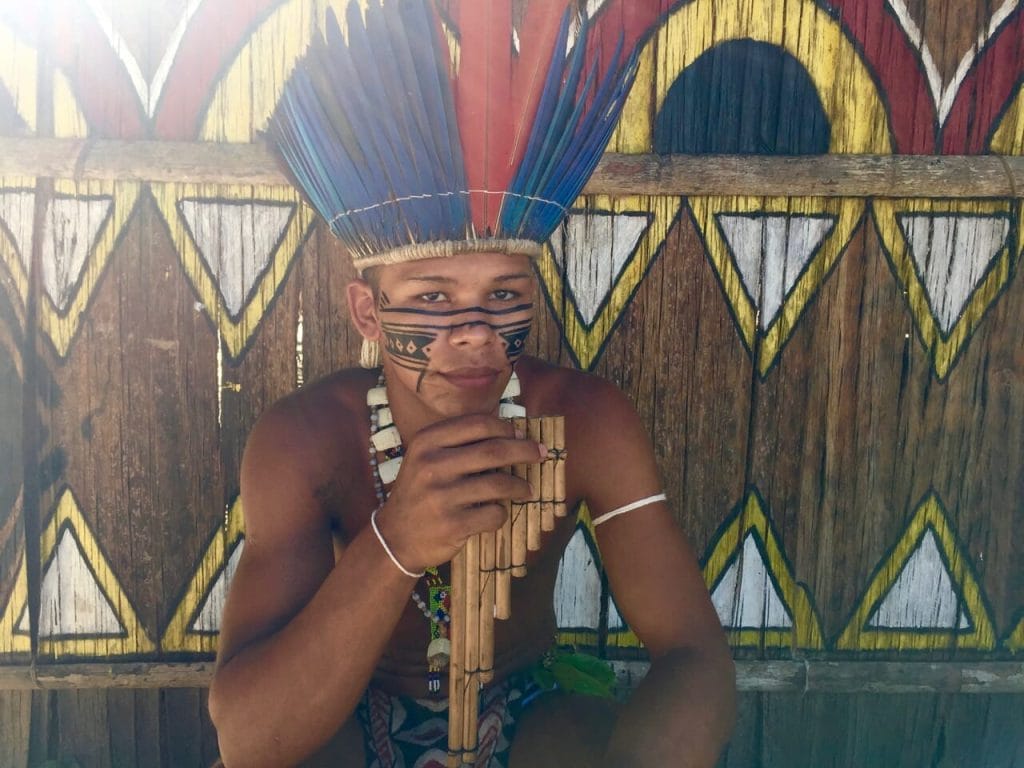
One of the reasons that I came to the Amazon and one of the highlights of this tour in Manaus was visiting an indigenous tribe.
The tribe that we visited in the excursion was the Aldeia Cipiá, who lives around 80Km from the city. But despite its proximity, they still preserve the old ways.
When the boat arrived we were welcomed into a big hangar made of wood and fibres, decorated with indigenous paintings, by the xamã (the chief of the tribe). A man in his 60’s, with his face, partially painted, wearing a swimming suit covered by a piece of the painted sheet on the front and a leaf on the back, a beautiful necklace made of jaguar teeth, and a crown adorned with colourful feathers.
All the indigenous had gorgeous necklaces made of seeds, feathers and shells, painted faces and the men had awesome crowns and the women ravishing earrings.
The Rituals
The xamã started the presentation of the rituals to receive visitors. Jurupari’s dance, a supernatural god’s dance, was the first one. Because of that there is no participation of the women and children and they never saw the instruments. Teenage boys took their big blowing wood instruments and started making an interesting sound out of it, and moving it up and down. The rituals were just starting and I was exhilarated!
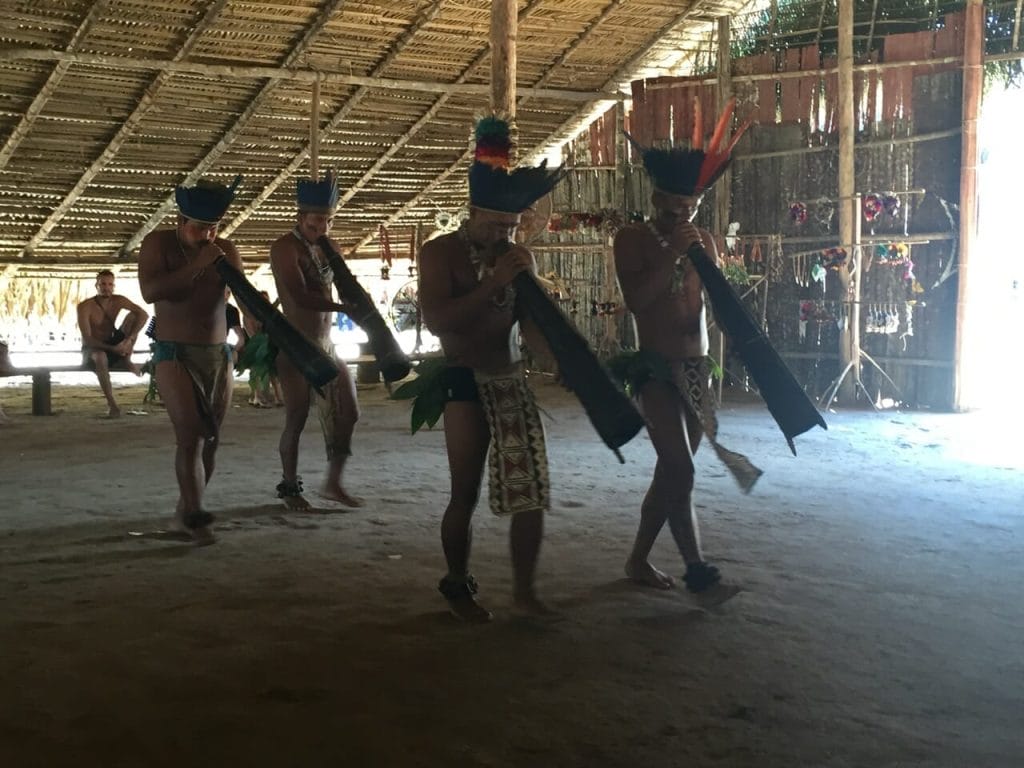
The next was Japurutú’s dance executed only by the men a dance that means offering of fruit, fishes, meat or crafts. They made a big circle, put their left arms on the right shoulders of the one in front and started to sing in their own language and make sounds with their instruments.
One by one, the women lined up in the middle of the circle and then every woman held every other man and did the Capiwayá’s dance. This dance means, “serve me” and was created to socialize and mix the languages and races because in the beginning they were all brothers and sisters and no one could get married.
They continued to sing and spin around the hangar using bamboos, rattles, clappers and wands. I was in awe witnessing an indigenous ritual for the first time.
In the end, they started to play a very festive song with their flutes for the Reunion dance. The men invited visitors women and the women invited visitors men to join them. It was a big celebration of the indigenous culture and heritage that is becoming very rare to preserve.
Every one of us, Brazilians and foreigners were moved at the end of the presentation.
Their Habitats
We had some free time to visit the village and also to buy art crafts. They live in a very simple way, in a few houses similar to the hangar in the middle of the forest, and they sleep in hammocks.
I took the opportunity to talk to a teenage girl who spoke perfect Portuguese and the tribe dialect, and she told me that she goes to a school close by. I also spoke with the xamã, who told me that they receive visitors and the daily activities are fishing and hiking in the forest.
I left the tribe very happy to see that they still preserve their culture, which is also my own culture that was lost after generations of city life. I felt proud to learn the early cultures of the Brazilian population because, in the end, we are all indigenous.
We returned to Manaus and I still had time to wander around the historic centre and admire its colourful old houses.
This tour not only provided me with remarkable experiences but also the opportunity to better understand the North of Brazil. For all these reasons this is definitely the best tour in Manaus!!
Watch video: Best Tour in Manaus

Visiting Manaus
- Where is it located?
[huge_it_maps id=”12″]
- How to get there?
Manaus is surrounded by rivers and the best way to get there is by boat or airplane.
∗ By airplane: Sadly there aren’t many international companies flying direct to Manaus. Some of them companies are: American Airlines, Copa Airlines and Insel Air.
Although there are plenty of flights from several cities in Brazil, specially from São Paulo and Brasília. The companies that fly frequently to Manaus are: TAM, Gol, Azul and MAP.
∗ By boat: there are many boats connecting Manaus with other cities in the North of Brazil, and also with Colombia and Peru. Those boats are huge and you sleep in a hammock (you have to buy it).
To Colombia and Peru, it takes, in general, one week. One of the most common trips is from Manaus to Belem (Pará’s capital) and it takes three and a half days.
- Best time to go
There are basically two seasons in Manaus: the rainy and high humidity season (from December to April), and the dry and very hot season (from July to September).
So, the best time to go is the shoulder season: May/June and October/November.
I was there for seven days at the beginning of April of 2016 and four days the weather was sunny and hot, one cloudy day and two days with heavy rain.
- Where did I stay?
∗ I stayed at Local Hostel Manaus.
- Travel costs
∗ Flight from São Paulo to Manaus: R$ 349 (US$ 100).
∗ Five nights at Local Hostel Manaus: R$ 235 (US$ 67).
∗ Tour with Amazing Tours: R$ 300 (US$ 86).
Additional Links
For more information about Manaus visit: www.visitamazonastour.com
To book this tour in Manaus and others visit: www.manausjungetours.com
To check boat schedules and prices visit: www.portodemanaus.com.br
P.S.: Don’t forget to take the yellow fever vacine at least ten days prior to arrival.
∗ I was invited by Amazing Tours to take this tour in Manaus and all the opinions here are on my own and unbiased.
- Book Your Flight Find deals on airlines on my favorite search engine: Skyscanner. Be sure to read my How to find cheap flights article.
- Rent A Car Rental Cars is a great site for comparing car prices to find the best deal.
- Book Accommodation Booking.com is my favorite hotel search engine. But Hotels.com and Hilton Hotels have very interesting reward programs.
- Protect Your Trip Don’t forget travel insurance! I always use World Nomads for short-term trips and SafetyWing for long-term ones. Find out why Travel Insurance: Much More Than a Precaution, a Necessity.
- Book Tours in Advance Book unforgettable experiences and skip-the-line tickets with GetYourGuide or Viator .
- Book Ground Transportation BookaWay offers a stress-free experience with secure payments and no hidden fees. You pay online and receive your itinerary by email.
- Luggage Solutions Rent your luggage with Cargo or if you need to drop off your own luggage and enjoy your time without dragging it all over a city, find a LuggageHero shop here.
- Get a Travel Card Revolut Card is a pre-paid debit card that enables cash machine withdrawals in 120 countries. I’ve been using my Revolut Card for over a year and never paid foreign-transaction fees again. Get your Revolut Card with free shipping here.
- Packing Guide Check out my How to Pack a Carry-on Luggage For a Five-month Trip to help you start packing for your trip. Don’t forget your camera, chargers and other useful travel accessories. World Nomads provides travel insurance for travelers in over 100 countries. As an affiliate, we receive a fee when you get a quote from World Nomads using this link. We do not represent World Nomads. This is information only and not a recommendation to buy travel insurance.

